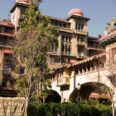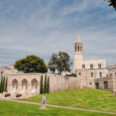
The rare event of a total solar eclipse will darken skies along a 115-mile-wide path across North America Monday, but the Southland will see only a partial eclipse.
The total eclipse, where the moon fully blocks the light of the sun for several minutes, will make landfall along Mexico’s Pacific coast and cross into Texas and 14 other U.S. states before exiting over Canada. Elsewhere in North America, including Los Angeles, there will be a partial eclipse.
The moon will shroud the sun for up to 4 minutes, 28 seconds. The celestial event is expected to draw millions of people to cities and towns in its path.
Pasadenans can join a free Solar Eclipse Viewing event hosted by the Cahill Center for Astronomy & Astrophysics at the California Institute of Technology. Scheduled for Monday from 10 a.m. to noon, attendees will be treated to the celestial spectacle of the partial solar eclipse, with peak coverage expected to reach approximately 50% at 11:13 a.m.
Caltech Astro will provide solar telescopes and eclipse glasses (while supplies last) to ensure safe viewing of the eclipse. Additionally, the event promises interactive science demonstrations and the invaluable presence of professional astronomers, who will be available to field questions and share insights into this astronomical phenomenon.
The event is free and requires no reservations. For more information, including directions to the venue, visit http://outreach.astro.caltech.edu.
Online, L.A.’s Griffith Observatory will host a live broadcast from Belton, Texas, from 10 a.m. to 1 p.m. Monday. A maximum partial eclipse in Los Angeles is expected at 11:12 a.m., with the moon expected to cover 57% of the sun’s diameter and 49% of the sun’s area, according to observatory officials.
The observatory will not host an in-person viewing event. However, Cal State Long Beach’s Department of Physics and Astronomy will hold one starting at 10 a.m. on the campus’ upper quad. According to the school, eclipse safety glasses and access to solar telescopes will be available.
Griffith Observatory officials cautioned that proper eye protection is essential when looking at the sun. The eclipse is only safe to witness with the naked eye during totality, or the period of total darkness when the moon completely covers the sun.
“We encourage everyone to purchase eclipse glasses or Solarama devices … at the Observatory’s Stellar Emporium book store and to watch the partial eclipse in Los Angeles from home,” observatory officials said in a statement.
The Los Angeles County Department of Public Health also reminded residents to take necessary precautions while viewing the eclipse.
“As we anticipate viewing the solar eclipse, I urge everyone to prioritize their eye safety,” County Public Health Director Barbara Ferrer said in a statement. “The sun’s powerful rays can cause serious eye damage if you look directly at it during an eclipse. By following simple precautions and using certified eclipse glasses and avoiding direct sun gazing, we can safely enjoy this amazing natural phenomenon.”
The health department released the following guidelines:
- Do not look directly at the sun;
- Do not use sunglasses, binoculars, or telescopes;
- Always supervise children using solar viewers;
- Use a pinhole viewer to view the eclipse indirectly without looking at the sun; and
- Wear eclipse glasses, or solar viewers, with certified solar filters and ensure lenses are in good condition.
The next partial eclipse visible in the Los Angeles area will be on Jan. 14, 2029. The U.S. won’t see another total eclipse until 2044.














 25 comments
25 comments



